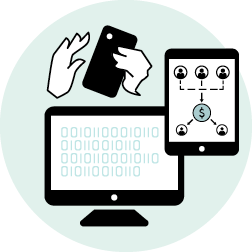Back in the olden days – fall 2020 – we wrote a blog post and participated in a podcast about customer experience (CX). One of the points we made is that customer experience is a program – an ongoing effort – rather than a project, or work that has an end date.
That’s even more true than when we said it just six months ago.
Why? Because of COVID, of course.
In a time of great and ongoing change, CX must continue to change with it. And the mindset that revamping your customer experience is an every-so-often effort has to disappear permanently if an organization wants to stay competitive.
Life Can Change on a Dime
If the coronavirus has taught us one thing, it’s that life as we know it can change on a dime. Some requirements and habits of the past year will fade away as the virus subsides. For example, people will be eager to go back to restaurants, tired of relying on cooking, take-out and delivery for meals.
Some changes will remain, but with modification. After a year of employees working full time from home, hybrid office models will likely emerge, for example, people will split their time between working from home and in the company office.
Still other changes are here to stay. One primary example? Online purchasing.
Reports throughout 2020 showed a drastic increase in ecommerce, but now final figures are in for the year: total U.S. ecommerce sales jumped 32.4% year-over-year, reaching $791.7 billion, according to the U.S. Census Bureau.
No one is expecting online shopping to decline as we ease into the post-pandemic world. Ecommerce has surpassed levels not previously expected until 2025, according to the IBM U.S. Retail Index, and estimates indicate that it will bring in more than $843 billion in sales this year.
Online shopping is easy, safe, and fun, and it may be an even better fit for our lives after the pandemic, when we’ll be out and about, and potentially busier than ever (making up for lost time stuck at home!). And ecommerce isn’t limited to personal consumption: plenty of B2B sellers and buyers participate, too.
Businesses Need to Respond with New CX Practices
With businesses facing this dramatic and permanent change, a recent McKinsey report outlines four CX practices that can guide short-term responses and build a foundation for success going forward:
- Focus on care and connection – reach out, prioritize employees and community, stay true to company values
- Meet customers where they are today – innovate digital models, expand home delivery, consider contactless operations
- Reimagine CX for a post-COVID-19 world – migrate customers to digital channels
- Build capabilities for a fast-changing environment – use social media to understand customers, solicit employees for insights, test and scale new offerings.
The McKinsey report offers considerable food for thought concerning CX both near- and long-term:
In a decidedly difficult time, the customer experience must be easier than ever. That applies to payment processes just as much as it does browsing a site to make selections. How many times have you abandoned a shopping cart because payment was too slow or too complicated?
With so many available options and a continuously growing number of people shopping online, an intuitive and speedy CX from start to finish is critically important and can be a competitive advantage. And once shoppers have that kind of experience, there’s no going back, for them or for a business. You’ve raised expectations and need to continue to meet and exceed them.
In the online payments world, that means greater adoption of secure card-on-file options to make it easy for returning customers. It means acceptance of a wide range of payment methods such as ACH direct debit and the full range of payment cards, like UnionPay. It also means having a website in the first place. Some 60% of B2B sellers don’t, interestingly enough. However, with a well-designed website or portable shopping cart that supports selling on social and others’ websites, B2B sellers can provide the same kind of seamless experience consumers have come to expect.
CX has moved outside a company’s typical reach – and the experience isn’t as easy to control. Take grocery delivery. A customer might be ordering and paying for goods through a grocery chain’s app, but who selects their groceries and where does the tip go? That’s right – to third party delivery services, typically.
And while the grocery chain might make it very clear that purchases are picked and delivered by another entity, it certainly doesn’t feel that way to customers. Who do they blame when the order isn’t right? Most likely the grocery store, not the delivery service. And that’s not good for business. A recent survey notes that a negative delivery experience impacts customers’ impression of a brand, not the delivery service itself. Those same customers will post about their dissatisfaction on social media, the survey says.
So while CX typically spans every touchpoint with a company, the part beyond payment, in this case, isn’t in the company’s control. All the more reason to make certain that the other elements of customer experience, including a functional website and smooth payment process, are top-notch – and that your partnership with delivery services fulfills your brand promise.
While it may not be obvious, the quality and satisfaction of employees also plays an important role in the customer experience. Your business has been tested like never before, but so have your employees – the very heart of the experience you provide to customers. McKinsey’s research showed that 43 percent are very or extremely concerned about their job or income and not being able to make ends meet. Some companies are taking steps to support their employees during this challenging time by continuing to pay employees both hourly and salaried, even if they aren’t always able to work. And some employers are adopting technology that allows them to pay workers more frequently – even after each shift. Smoothing out the ebb and flow of pay helps alleviate financial stress and can make employees more productive and reduce absenteeism. And experts agree that stability in staffing with employees that are less stressed are more likely to provide a more satisfying customer experience.
Adapting and Thriving No Matter the Circumstances
With much of life shifted online and likely to stay that way even after the pandemic, the online customer experience is just as important as the in-person CX – and in some cases, possibly more so. The good news is, a constantly changing environment means regular opportunities to learn and adapt. Companies that evolve their CX in response to those changes (or even anticipate it and get ahead of the curve) will position themselves to stay alive and even thrive no matter the circumstances.
MerchantE can help you ensure that your business is set up for scalable growth as more and more consumers—and B2B businesses—shift their behaviors.
Get more information about our products and services today!




